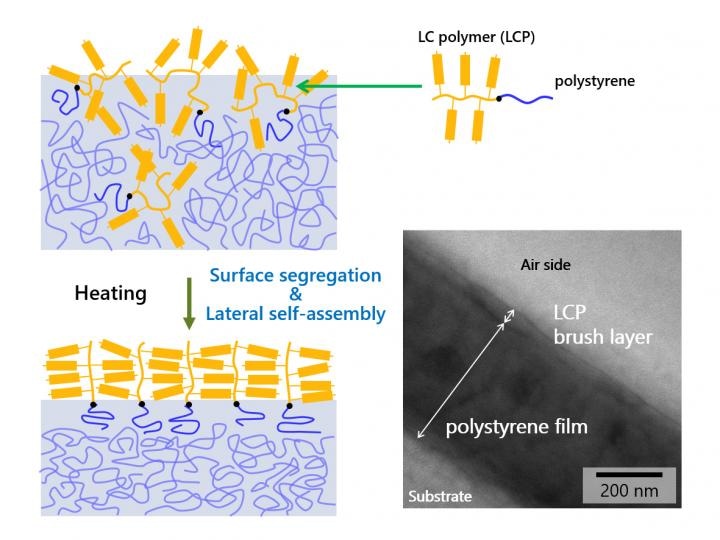Oct 21 2016
 Schematic depiction of polymer brush formation through the surface segregation and lateral self-assembly of a block copolymer consisting of a liquid crystalline polymer (LCP) connected with polystyrene on a polystyrene base film. The photo displays a transmission electron microscopic (TEM) image showing the extended polymer brush layer formed on the air side of a polystyrene film. Credit: Koji Mukai & Takahiro Seki
Schematic depiction of polymer brush formation through the surface segregation and lateral self-assembly of a block copolymer consisting of a liquid crystalline polymer (LCP) connected with polystyrene on a polystyrene base film. The photo displays a transmission electron microscopic (TEM) image showing the extended polymer brush layer formed on the air side of a polystyrene film. Credit: Koji Mukai & Takahiro Seki
The surface coatings of polymer materials are important in various applications to produce useful surface functions such as low friction, biocompatibility and wettability. The grafting methods are normally used to modify surfaces with polymers in order to create chemical bonds between both the polymer and surface.
The type of grafting method can affect the ordering and properties of the polymer coating. For instance, polymer brushes are polymers that are tethered vertically to the underlying surface, and they can exhibit rather different properties to the corresponding polymer with random orientation. These polymer brushes are typically produced by the polymerization process initiated at surfaces.
A group of researchers from Nagoya University have developed an innovative approach to obtain polymer brushes on surfaces by using diblock copolymers containing two kinds of units for forming segregated structures.
The formation of polymer brushes was driven by the ability of our copolymers to segregate and self-assemble on a base polymer surface when heated appropriately.
Shusaku Nagano, Nagoya University
At first, the researchers produced diblock copolymers containing poly(azobenzene) (PAz) and polystyrene (PS)-based units. These PAz and PS units had different properties like energy and flexibility, and this caused the copolymers to separate into their different blocks on the PS substrate surfaces during annealing at a higher temperature compared to the glass transition temperature of PS.
The separation was confirmed by transmission electron microscopy, X-ray photoelectron spectroscopy and contact angle measurements. The team discovered that a "skin" was formed by the PAz units on the PS surface. The PAz skin layer’s thickness relies on the ratio of the two polymer units in the copolymer.
The main PAz chain was highly expanded to produce a polymer brush structure in the skin layer. The polymer brush structure was mainly attributed to the presence of the large azobenzene units of PAz.
Ultraviolet-visible absorption measurements showed that during annealing, a PS substrate prevented gathering of the diblock copolymer. The main PAz chains were horizontally oriented in a copolymer film. Conversely, an underlying PS surface triggered the main PAz chains to be vertically oriented with respect to the surface.
This happens because when the PS units of the diblock copolymer act together with the underlying PS layer, causing the formation of a vertically-oriented PAz unit surface layer arranged as densely packed polymer brushes. This structure formation was mostly driven by the low surface tension of the PAz units than the PS units, and the PAz units’ ability to self-assemble.
The advantages of this method include easy controllability of the structure and thickness of the polymer brush by modifying the type and/or number of units in the diblock copolymer and the capability to synthesize polymer brushes on flexible substrates.
These organized polymer surfaces are stable in air and should be resistant to damage. A damaged surface should be able to self-heal simply by annealing because of the lateral mobility of the polystyrene anchoring units.
Koji Mukai, Nagoya University
In addition, the photosensitive azobenzene units of the PAz brushes can be aligned further through exposure to light irradiation. This method can also be expanded to attain efficient surface coatings using the self-assembly and segregation of diblock copolymers to various other polymer systems.